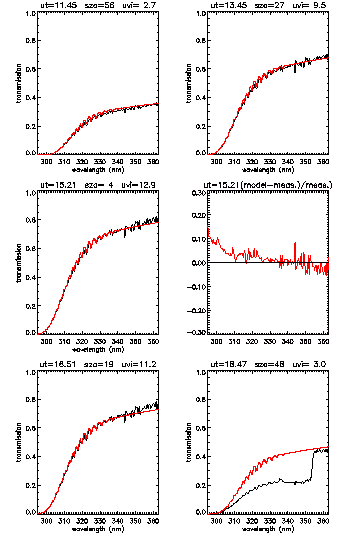
Previous: Site Description Next: Annual Variation Up: Ext. Abst.
Comparison with RT Model Calculations
The UV spectra have been checked extensively against accurate discrete-ordinate RT model calculations for their stability, wavelength alignment and overall consistency. Therefore, the absolute measurements are divided by a solar spectrum (Atlas-3), which has been convoluted with the Brewer slit width. This is the 'observed atmospheric transmission', which is compared with a modeled transmission. In the model calculations we use the measured Brewer ozone column. The aerosol extinction in the model is very low: 0.09 at 320 nm. Figure 2 shows five 'observed transmission' spectra on 17 September 1999, which was an almost cloud-free day. The measured ozone column was 281 DU with little diurnal variation. In red are the model calculations. Very good agreement is found. A difference plot is given for the noon spectrum to show that deviations are within 10\% for this case. The good agreement also indicates that the assumption of low aerosol load is valid on this day. The advantage of the applied comparison method between measurements and model calculations is that unexpected deviations can easily be detected and the causes investigated. For example, the last spectrum shows the effect of a passing cloud. The sun just returned on the instrument before the spectrum was fully recorded.

Figure 2. Comparison of five measured transmission spectra (black) with RT model calculations (red) for 17 September 1999. The figure in the middle on the right shows the relative differences that correspond with the figure on the left (both at 15h21 UT which is about local noontime).